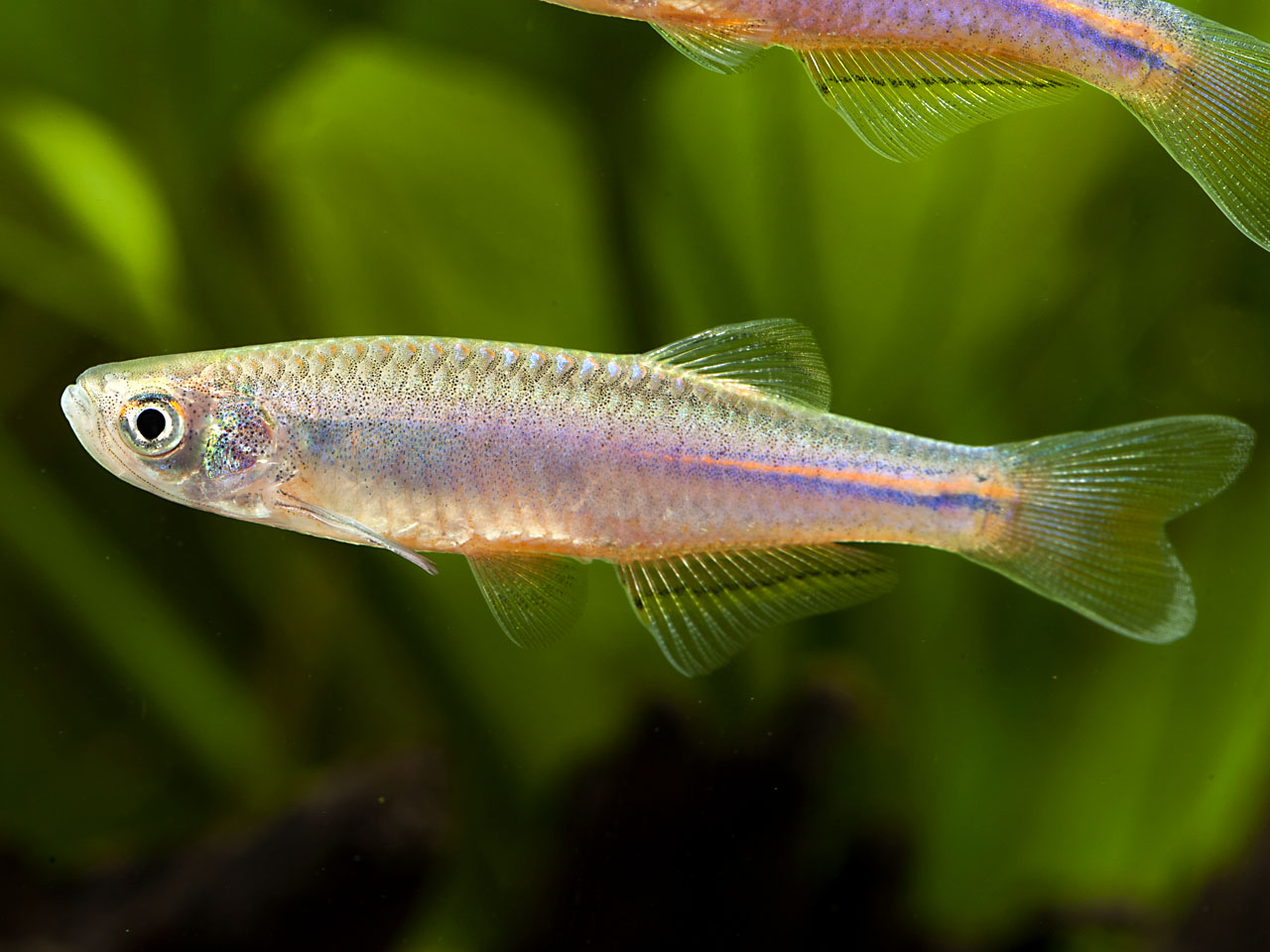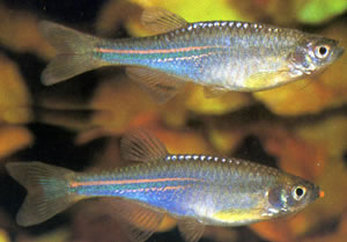Pearl Danio
The Pearl Danio – Danio albolineatus, is a stunning, vibrant fish that rookie aquarists will find fitting for their setup. Its resilient nature, minimal demands, and adaptability to various water conditions are a plus.
- Experience Level: Beginner
- Hardiness: Hardy
- Minimum Tank Size: 20 gal (75 L)
- Maximum Size: 2 inches (5 cm)
- Temperament: Peaceful
- Temperature: 64 – 74° F (18 – 23.5° C)
- pH Range: 6.5 – 7
- Water Hardness: 5 – 12 dGH
- Diet: Omnivore
Table of Contents
Introduction
Size and Appearance
Care Guide
Tank Mates
Diet and Feeding
Breeding
Its calm demeanor makes it a perfect fit for a vegetated community tank where it schools harmoniously with the majority of widely-kept aquarium fish. With an appetite not particularly picky, it savors a diverse diet similar to other fish.
Since their first importation into Europe in 1911, Pearl Danios have been a beloved aquarium fish. Native to the rivers and rapid streams flowing through Myanmar, Thailand, and Sumatra, the fish has a variety of habitats.
These areas include well-oxygenated rivulets with pebble substrates flowing through forested areas and stationary water bodies, such as trenches, ponds, and rice fields.
Size and Appearance
This species gets its name “pearl danio” from the pearly sheen that illuminates its body with attractive color patterns. When exposed to bright lights, a blue or purple sheen is reflected from their bodies.
Their banished pink bodies have a stripe that varies from yellow to red, stretching from the dorsal fin to the caudal fin. Pearl danios boast neon- orange or yellow eyes and an olive tinge on the body, with their fins spotting subtle yellowish shades.
These fish particularly enjoy the early morning sunlight. An aquarium placed near a window provides a front-row seat to the fascinating iridescent color of these fish in natural light.
Male pearl danios are usually trimmer and more petite compared to their female counterparts, although they exhibit brighter colors. An adult fish typically measures 2 inches, but some can grow up to 2.5 inches. Pearl danios feature two pairs of barbels and a forked tail.
Care Guide
- Minimum Tank Size: 20 gal (75 L)
- pH Range: 6.5 – 7
- Water Hardness: 5 – 12 dGH
- Temperature: 64 – 74° F (18 – 23.5° C)
- Lighting: Moderate, diffused lighting
- Substrate: Fine sand/gravel, mud
- Brackish: No
- Water Flow: Weak/Low
- Tank Region: Mid to top
Pearl danios are exceptionally active and enthusiastic breeds. They prefer spacious tanks with a capacity between 20 and 75 gallons. Ideal water conditions for this fish include a temperature of about 64 – 74 F and a fair pH of 6.5 – 7, with moderately hard water.
The iridescent colors of pearl danios are most radiant in a densely vegetated setting against a dark substrate. In designing a riverine aquarium, aim to mimic the natural environment of Danio albolineatus found in flowing rivers and streams. A perfect substrate would consist of variously sized stones and a couple of large, water-smoothened boulders arranged in gravel.
Secure anubias and water ferns onto driftwood and rocks, since they’re hardy enough to withstand a reasonably strong current. Bottles and Microcosm are other suitable plant options. With sufficient sunlight, these plants will flourish rapidly and abundantly. Ensure your water carries ample nutrients for these fish.
Incorporate driftwood roots and branches to provide cover for the pearl danios. Pearl danios necessitate slightly more oxygen levels than other danios, thus, functional filtration is essential. These fish handle cooler temperatures well, and you can keep them in non-heated aquariums.
Additionally, you may utilize filter outlets or powerheads to generate a moderate current. Be cautious to avoid potent currents, as petite danios naturally occur in the serene stretches and marginal areas in their natural habitat.
As pearl danios are skilled jumpers and can squeeze through tiny gaps, securing a tight-fitting aquarium cover is crucial.
Tank Mates
Pearl danios look striking in a species-specific aquarium. Their calm temperament also makes them perfect for community aquariums, as they harmoniously coexist with any peaceful fish.
Given their ability to tolerate a vast range of water conditions, they’re compatible with various other fish. However, it’s crucial to consider their robust nature and endless activity when selecting tank mates.
Best avoid small, sluggish tank mates with a laid-back approach during feeding time.
Here’s a lengthy yet not exhaustive list of compatible species:
- Anabantids
- Livebearers
- Barbs
- Catfish
- Rasbora
- Rainbowfish
- Loaches
- Tetras
- Microrasboras
- other small Danios
Being shoaling fish, pearl danios are happiest in groups of five or more. Isolated in a tank, these fish might become a bit anxious and often retreat to the aquarium’s upper corners.
Pearl danios are lively and exuberant, keeping busy chasing each other throughout the tank. Interestingly, no matter how playful they get, it seldom results in injuries. However, this activity level might be a little stressful for some of the more reserved fish in the group.
What sets pearl danios apart is their role as dither fish. If your aquarium houses shy fish species, you’ll find the consistent, twirling swimming patterns of pearl danios soothing, encouraging nervous fish to leave their refuge.
In larger groups of eight plus, the male pearl danio exhibits more striking colors as they compete for female attention.
Feeding Guide
- Diet: Omnivore
- Frequency: Several small feedings per day
- Pellet Foods: Yes
- Flake Foods: Yes
- Live Foods: Yes
- Meat Foods: Yes
- Vegetable Foods: Yes
Pearl danios are omnivores, feeding mainly on insects and larvae in their natural habitat.
In the aquarium, the brine shrimp, mosquito larvae, zooplankton, daphnia, live and frozen bloodworm, tubifex, and good quality small pellet and flake foods make them quite happy.
Just like other danio species, pearl danios prefer to stay in the upper half of the aquarium, swimming near the water’s surface. This behavior is a reflection of their feeding habit in the wild where they consume small insects at the water surface.
However, the robust nature of the pearl danio species enables them to eat at mid-water or even at the substrate. This depends on the feed types you add to your aquarium.
Since the pearl danio fish are always on the move, they’re constantly looking for their next feed. Therefore, be cautious to secure your aquarium lid tightly after adding food. They may leap out of the tank when jumping to reach floating foodstuff.
Pearl danios are not particularly fastidious eaters. They will gladly settle for nearly any commercial aquarium food served to them, but a wholesome diet will significantly promote their color and health. Switch between brine shrimp flakes, spirulina flakes, color-enhancing flakes, and a frozen mix of brine shrimp and bloodworm.
Small live foods are not a necessity for the pearl danio’s wellbeing, but they come in handy in triggering the spawn process if used.
Breeding
Pearl danios, like other danios, lay eggs and are relatively easy to breed, forming breeding pairs. Unlike several small cyprinids, the breeding pair does not attend to their fry.
Feed them protein-rich foods like brine shrimp, bloodworms, or tubifex worms for a week or so to condition the pearl danio. This diet helps the females in the development of the roe.
Well-maintained, healthy pearl danios produce more eggs. Endeavor to maintain twice as many females as males in the tank, and you can condition the group together.
Simulate the rainy season in their natural habitat by gradually adding tiny amounts of cold water to the tank every few hours to induce spawning. Alongside, feed the adults tiny quantities of frozen and live foods. The pearl danios should spawn the next day.
Swollen bellies denote the females’ readiness to spawn; it’s a sign the body is full of eggs. Near dusk, transfer pairs to the breeding tank, as spawning generally occurs at dawn. A breeding female releases approximately 300 eggs, which the trailing male fertilizes.
Noticing a noticeably slim appearance in the female suggests she has laid the eggs. Following spawning, promptly remove the adults to avoid cannibalism of the eggs.
To see fries hatch naturally in your thickly planted, mature aquarium, no interference is required.
However, to harvest a greater number of more fry, you might have to adopt a slightly controlled approach.
For breeding, set up 5 to 8 gallons containers. Keep the temperature of the breeding tank warm, between 79 to 86 degrees F, and fill it with 4 to 6 inches of heated, mature water. The ideal water pH should be slightly acidic, leaning towards neutral.
A small power filter could be installed, positioned to direct the flow along the length of the tank. Also, fix an air stone for oxygenation and circulatory purposes.
Fine-leaved aquatic plants caged into a cluster or left to float serve well. Marbles make the best substrate. The eggs drop through the spaces between the marbles, keeping them out of adults’ reach.
If marbles aren’t available, plastic ‘grass’-type mats widely available also work well. Alternatively, fill most of the tank with Java moss or place a spawning mop at the bottom of the tank.
Caring for the fry
The eggs’ incubation is influenced by water temperature. While the eggs grow, keeping the tank dim helps prevent fungal growth.
The adult fish will consume any eggs within their reach; thus, it’s recommended to transfer them back to the main tank after two days.
The fry hatch within 36 to 48 hours. At this point, substitute the power filter for a mature sponge-type filter to prevent the fry from being sucked into the mechanism.
Young pearl danio fry grow quickly and become free-swimming within six to seven days. Initially, feed them Paramecium, finely powdered dry food, or any proprietary dry food. Ensure the food particles are small enough (5 to 50-micron diameter) for them to eat.
If you don’t have small dry food available, liquid food for egg-laying fish can be used. The fry will be too tiny to consume large food particles at this stage.
Once the fry grows large enough, you can introduce them to Artemia nauplii, freshly hatched brine shrimp, infusoria, or microworms.



